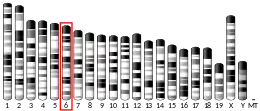| PRSS3 | |||||||||||||||||||||||||||||||||||||||||||||||||||
|---|---|---|---|---|---|---|---|---|---|---|---|---|---|---|---|---|---|---|---|---|---|---|---|---|---|---|---|---|---|---|---|---|---|---|---|---|---|---|---|---|---|---|---|---|---|---|---|---|---|---|---|
| |||||||||||||||||||||||||||||||||||||||||||||||||||
| Identifiers | |||||||||||||||||||||||||||||||||||||||||||||||||||
| Aliases | PRSS3, MTG, PRSS4, T9, TRY3, TRY4, protease, serine 3, serine protease 3 | ||||||||||||||||||||||||||||||||||||||||||||||||||
| External IDs | OMIM: 613578 MGI: 102757 HomoloGene: 106639 GeneCards: PRSS3 | ||||||||||||||||||||||||||||||||||||||||||||||||||
| |||||||||||||||||||||||||||||||||||||||||||||||||||
| |||||||||||||||||||||||||||||||||||||||||||||||||||
| |||||||||||||||||||||||||||||||||||||||||||||||||||
| |||||||||||||||||||||||||||||||||||||||||||||||||||
| |||||||||||||||||||||||||||||||||||||||||||||||||||
| Wikidata | |||||||||||||||||||||||||||||||||||||||||||||||||||
| |||||||||||||||||||||||||||||||||||||||||||||||||||
Protease, serine, 3 is a protein that in humans is encoded by the PRSS3 gene.[5]
Function
This gene encodes a trypsinogen, which is a member of the trypsin family of serine proteases. This enzyme is expressed in the brain and pancreas and is resistant to common trypsin inhibitors. It is active on peptide linkages involving the carboxyl group of lysine or arginine. This gene is localized to the locus of T cell receptor beta variable orphans on chromosome 9. Four transcript variants encoding different isoforms have been described for this gene.
References
- 1 2 3 GRCh38: Ensembl release 89: ENSG00000010438 - Ensembl, May 2017
- 1 2 3 GRCm38: Ensembl release 89: ENSMUSG00000054106 - Ensembl, May 2017
- ↑ "Human PubMed Reference:". National Center for Biotechnology Information, U.S. National Library of Medicine.
- ↑ "Mouse PubMed Reference:". National Center for Biotechnology Information, U.S. National Library of Medicine.
- ↑ "Entrez Gene: Protease, serine, 3".
Further reading
- Koistinen H, Koistinen R, Zhang WM, Valmu L, Stenman UH (April 2009). "Nexin-1 inhibits the activity of human brain trypsin". Neuroscience. 160 (1): 97–102. doi:10.1016/j.neuroscience.2009.02.042. PMID 19249338. S2CID 23924027.
- Tani T, Kawashima I, Mita K, Takiguchi Y (March 1990). "Nucleotide sequence of the human pancreatic trypsinogen III cDNA". Nucleic Acids Research. 18 (6): 1631. doi:10.1093/nar/18.6.1631. PMC 330537. PMID 2326201.
- Hayashi H, Kohno T, Yasui K, Murota H, Kimura T, Duncan GS, Nakashima T, Yamamoto K, Katayama I, Ma Y, Chua KJ, Suematsu T, Shimokawa I, Akira S, Kubo Y, Mak TW, Matsuyama T (November 2011). "Characterization of dsRNA-induced pancreatitis model reveals the regulatory role of IFN regulatory factor 2 (Irf2) in trypsinogen5 gene transcription". Proceedings of the National Academy of Sciences of the United States of America. 108 (46): 18766–71. Bibcode:2011PNAS..10818766H. doi:10.1073/pnas.1116273108. PMC 3219097. PMID 22042864.
- Salameh MA, Robinson JL, Navaneetham D, Sinha D, Madden BJ, Walsh PN, Radisky ES (January 2010). "The amyloid precursor protein/protease nexin 2 Kunitz inhibitor domain is a highly specific substrate of mesotrypsin". The Journal of Biological Chemistry. 285 (3): 1939–49. doi:10.1074/jbc.M109.057216. PMC 2804352. PMID 19920152.
- Masson E, Le Maréchal C, Chen JM, Férec C (August 2008). "Absence of mesotrypsinogen gene (PRSS3) copy number variations in patients with chronic pancreatitis". Pancreas. 37 (2): 227–8. doi:10.1097/MPA.0b013e3181654b6a. PMID 18665091.
- Nyaruhucha CN, Kito M, Fukuoka SI (April 1997). "Identification and expression of the cDNA-encoding human mesotrypsin(ogen), an isoform of trypsin with inhibitor resistance". The Journal of Biological Chemistry. 272 (16): 10573–8. doi:10.1074/jbc.272.16.10573. PMID 9099703.
- Knecht W, Cottrell GS, Amadesi S, Mohlin J, Skåregärde A, Gedda K, Peterson A, Chapman K, Hollenberg MD, Vergnolle N, Bunnett NW (September 2007). "Trypsin IV or mesotrypsin and p23 cleave protease-activated receptors 1 and 2 to induce inflammation and hyperalgesia". The Journal of Biological Chemistry. 282 (36): 26089–100. doi:10.1074/jbc.M703840200. PMID 17623652.
- Huntington JA, Read RJ, Carrell RW (October 2000). "Structure of a serpin-protease complex shows inhibition by deformation". Nature. 407 (6806): 923–6. Bibcode:2000Natur.407..923H. doi:10.1038/35038119. PMID 11057674. S2CID 205009937.
This article incorporates text from the United States National Library of Medicine, which is in the public domain.
This article is issued from Wikipedia. The text is licensed under Creative Commons - Attribution - Sharealike. Additional terms may apply for the media files.



